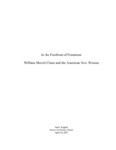At the Forefront of Feminism: William Merritt Chase and the American New Woman

View/
Author
Wagner, Sarah Elizabeth W.
Subject
Washington and Lee University -- Senior Thesis in Art History
Chase, William Merritt, 1849-1916
Feminism and art
Inspiration in art
Metadata
Show full item recordDescription
Sarah Elizabeth W. Wagner is a member of the Class of 2017 of Washington and Lee University. Thesis; [FULL-TEXT FREELY AVAILABLE ONLINE] Chase married Alice Gerson, whose father managed a large lithography firm, in 1886. She proved to be an inspiration for Chase throughout the rest of his life and frequently appears in his work. While other artists painted family members as well, having Alice as a common theme throughout Chase's body of work allows scholars to study her as a subject that remains consistent throughout his career. Chase was closely tied to his family and Alice often played more than the “typical” role as his wife. . . . Alice assumed this role but was also an active player in Chase's creative process . . . Interestingly, even with the wide breadth of research on Chase, there has not been anything written on his wife, Alice Chase, as a common outlet for him to depict the American New Woman. Intrigued by this idea, this thesis argues that William Merritt Chase was at the forefront of depicting empowered women in American art and pushed this agenda through the paintings of his wife, Alice Chase, as the American New Woman. His approach contrasts the representations of females completed by other prominent male artists during that time by placing the emphasis on the women's authority instead of on her body or other feminine attributes. [From Introduction]